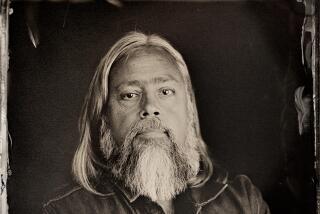Oxford, Miss.: The center of William Faulkner’s cosmos

“The past is never dead. It’s not even past,” William Faulkner wrote in 1951, two years after winning the Nobel Prize for literature. It’s one of his best-known lines, but I don’t think I ever truly understood it until I came to Oxford.
For more than three decades, since I first read “As I Lay Dying” as a high school senior, I regarded such a sentiment as a key to Faulkner’s writing — which continues to resonate because it comes drenched in history, in the interplay of the past and present, the bitter weight of heritage, the understanding that we cannot be cut free of our roots — without quite realizing that it was also a key to his life.
Without quite realizing, in other words, the extent to which it has to do with Oxford, the college town 85 miles southeast of Memphis where Faulkner was raised and where he lived and died and where he is buried, and where, beginning with his third novel, “Sartoris” (1929), he told the Paris Review in 1956, “I discovered that my own little postage stamp of native soil was worth writing about and that I would never live long enough to exhaust it, and by sublimating the actual into apocryphal I would have complete liberty to use whatever talent I might have to its absolute top.”
My own little postage stamp of native soil: Here we have another iconic riff, so much so that it has long since blurred into cliché. It refers to Faulkner’s decision, in 15 novels and dozens of short stories, to reframe Oxford as the seat of the fictional Yoknapatawpha County, “a cosmos of my own,” which he imagined as “a kind of keystone in the universe; that, small as that keystone is, if it were ever taken away the universe itself would collapse.”
That’s a great description, not just of his ambition but also of his aesthetic: the balance of myth and recollection, the desire to use this landscape as a template against which the human struggle might play out in epic terms. Still, spend a day (or two, as I did last month) or even an hour roaming Oxford and you begin to see how literal Faulkner’s vision was.
Oxford may be cosmopolitan, with high-end shops and eateries, but Oxford also is a small town, if not provincial then contained. This is both the charm of the place and its challenge, this interplay of geography and memory.
In a dozen or so spots, green historical markers dot the landscape like some strange species of vegetation. At the corner of Mississippi 6 and Jackson Avenue, one reads: “Oxford. Chartered, 1837. Was on Chickasaw Trail of Tears. Home of the University of Mississippi and of Barnard, Hilgard, Thompson, and Lamar. Burned by Federal troops in 1864.”
It’s impossible to miss the defiance in such a sign, the sense that even now, the past is not only unforgotten but also bluntly, unapologetically alive. The same is true of the Civil War memorial in front of the Lafayette County Courthouse, in the square at the center of Oxford: a statue of a Confederate soldier on a pedestal, facing south into the heart of Dixie, as if, as Faulkner wrote in “Go Down, Moses,” the “old times would cease to be old times and would become a part of the … present, not only as if they had happened yesterday but as if they were still happening, the men who walked through them actually walking in breath and air and casting an actual shadow on the earth they had not quitted.”
And yet, for all that Oxford seems immersed in history, it’s a nuanced immersion, or perhaps a nuanced idea of the past. The afternoon before I arrived, the Lyric Theatre — an old silent movie house where MGM’s adaptation of “Intruder in the Dust” (“You can’t film that novel,” the trailer asserts, “… but we did!”) premiered in 1949 — hosted a reading by the author’s niece, Dean Faulkner Wells, from her newly released “Every Day by the Sun: A Memoir of the Faulkners of Mississippi.”
Down the block at Square Books, the legendary independent bookstore across the street from the courthouse, Wells’ book filled the window display. Inside, I picked up a program for the 18th Oxford Conference for the Book, featuring writers such as Mark Richard (“House of Prayer No. 2”), Téa Obreht (“The Tiger’s Wife”), Karen Russell (“St. Lucy’s Home for Girls Raised by Wolves”) and Sven Birkerts (“The Gutenberg Elegies”), which would be held the following weekend at Ole Miss. Whatever else it is, Oxford has become literary territory, with roots that extend from Yoknapatawpha to the university.
Square Books was my first stop in Oxford. I walked east on Van Buren Avenue from the 5 Twelve Bed & Breakfast, passing the Old Venice Pizza Co., once the site of Devoe’s Gathright-Reed Drug Co., whose lending library Faulkner frequented a century ago. For years, Gathright-Reed was one of the few places in town to sell Faulkner’s books; until relatively late in his career, Faulkner was largely disregarded in Oxford, referred to as “Count No-Count” for his aloofness and his apparent aversion to hard work. This, of course, was not merely a local perspective: Before the 1946 publication of “The Portable Faulkner,” which collected and contextualized his writing, most of his books were out of print.
I found “The Portable Faulkner” at Square Books, in a large section devoted to him exclusively. I found his other books also, including two I didn’t know about: a collection of early poetry and one called “Essays, Speeches & Public Letters,” which I bought. I browsed for a bit, looking at the novels and nonfiction, taking in the wall of author photos, many signed, that rises from a landing between the second and third floors. At the register, the clerk smiled at my selection, marking me as a literary tourist, as yet another reader on the Faulkner trail.
It was hot as I walked South Lamar Boulevard, past the small home built in 1931 for Faulkner’s parents, through a residential neighborhood of large Victorians.
On Johnson Avenue, less than half a mile south of the square, I cut east to the Thompson-Chandler House, model for the Compson mansion in “The Sound and the Fury” (1929). There it was: the Greek Revival façade, the colonnaded portico, the long sloping yard where the four Compson children play during their grandmother’s funeral.
“The Sound and the Fury” helped establish Faulkner’s reputation for difficulty — of its four sections, one is narrated by the mentally handicapped Benjy and another by his brother Quentin, a schizophrenic on the cusp of suicide. If the Thompson-Chandler House has anything to tell us, it’s how rooted in the actual is Faulkner’s apocrypha. Benjy was based on Edwin Chandler, who lived in the house when the author was a boy; Compson is said to be a combination of Chandler and Thompson.
At the same time, it’s important not to be reductive, for Faulkner’s genius lies in both how he reflected his own world and how, on this ground, he uncovered something universal and profound. “I believe,” he said in his Nobel Prize acceptance speech, “that man will not merely endure: He will prevail. He is immortal, not because he alone among creatures has an inexhaustible voice, but because he has a soul, a spirit capable of compassion and sacrifice and endurance.”
That’s the message of his writing, or one of them anyway, the dignity of perseverance. As he observes of Dilsey, the matriarchal servant in “The Sound and the Fury” who becomes a symbol for every black character in the novel (and, indeed, throughout his oeuvre): “They endured.”
You can find such quotes, along with a host of Faulknerian ephemera, at Rowan Oak, the antebellum pile the author bought in 1930 and where he lived until his death in 1962. I walked there in 10 minutes from the Thompson-Chandler House, and as I did, a creeping awareness settled in. I’d imagined the geography as more sprawling, yet here everything was, right in town. “It all unfolded in his neighborhood,” I thought as I moved through his house, now a museum administered by the university.
In the library, Faulkner’s pipe sat in an ashtray next to his reading chair; his glasses lay open on a desk. In the office, built in the 1950s, his notes for the novel “A Fable” remained as he had left them, inscribed in graphite and red grease pencil on the walls. By the front door hung two maps of Yoknapatawpha County, one from the 1936 novel “Absalom, Absalom!” (signed “William Faulkner, Sole Owner and Proprietor”) and the other from “The Portable Faulkner.” I knew these maps, but looking at them now, it was as though I had never quite seen them, as if I had misunderstood their economies of scale.
I kept thinking about this as I wandered across town, from Rowan Oak to the house at 910 Buchanan Ave. where Faulkner lived as a boy, after his family moved to Oxford shortly before his fifth birthday in 1902. A few blocks north, at 803 University Ave., I found the Meek-Duvall House, where the author and his wife, Estelle, rented rooms after their 1929 marriage, and where he wrote “As I Lay Dying” and “Sanctuary.”
Half a mile west, on the Ole Miss campus, I visited the site of the former university post office where he worked in the early 1920s. (“I refuse to place myself at the beck and call of every S.O.B. with the price of a two-cent stamp,” he insisted, when asked to resign for neglecting his duties in order to write.)
Late in the day, after walking out North Lamar to the bend in the road where old Bayard dies in “Sartoris,” I wound up at St. Peter’s Cemetery on the northeastern side of town. There, beneath three trees along the edge of North 16th Street, Faulkner is buried, next to Estelle, beneath a flat slab inscribed with his name and dates and the declaration, “Beloved Go With God.” Beside the plot, someone had left an empty bottle of Jack Daniel’s, flowers in its neck.
Up the hill, the inscriptions on tombs from the 1800s have been wiped nearly clean by wind and time. I stayed for a few minutes, aware of that tension between geography and history, between the present and the past. In the broadest sense, I had traveled nowhere in Oxford, a loop of a few miles at best. And yet, from Buchanan Avenue to Rowan Oak to this ancient graveyard, I had traversed the span of Faulkner’s life.
How had he done it? How, in such a postage stamp of soil, constrained in many ways by its conflicted heritage, had he found not just a personal vision but also one that seems to me large enough still to encompass all the strivings and frustrations, the love and loss and torment of humanity?
The answer, I’d suggest, resides with him. That night, in my room at the 5 Twelve, I paged through “Essays, Speeches & Public Letters,” reading his Nobel speech and his eulogy for Caroline Barr, on whom he modeled Dilsey, “born in bondage and with a dark skin and most of her early maturity was passed in a dark and tragic time for the land of her birth.” I read a long essay from the 1950s, titled “Mississippi,” in which he invokes both Yoknapatawpha and Oxford, conflating his characters — “the Sartorises and De Spains and Compsons” — with the members of his family, the saga of the state with his private longings and identifications, concluding that he has no choice but to “[love] all of [Mississippi] while he had to hate some of it because he knows now that you don’t love because: you love despite; not for the virtues, but despite the faults.”
What Faulkner is referring to, of course, is the disaster of discrimination, but there is something more elusive on his mind. “Home again,” he writes, “his native land; he was born of it and his bones will sleep in it.” This is it, the core connection, in which the past is never dead but somehow continuous, and history is always just a block or two away.
More to Read
Sign up for The Wild
We’ll help you find the best places to hike, bike and run, as well as the perfect silent spots for meditation and yoga.
You may occasionally receive promotional content from the Los Angeles Times.







